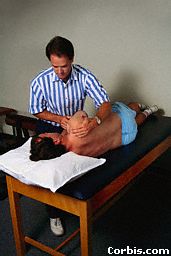

 The
debate continues about whether York should become affiliated with the Canadian Memorial
Chiropractic College (CMCC.) While York's senate has already approved the affiliation in
principle, some are concerned about the scientific uncertainty of chiropractic treatments.
While the beliefs and practices of chiropractors vary, some chiropractors believe that the
cause of most diseases is pinched nerves, which they can cure by readjustment of the
vertebrae. Consequently, they do not believe that immunization is necessary. Some claim
that chiropractic manipulations can help patients suffering from athsma, upset stomachs,
colic, and headaches, although there is no scientific evidence of this. Even the
effectiveness of chiropractic treatments on lower back pain is questionable. In a study of
people with back pain, researchers found no statistically significant difference between
the results of chiropractic treatment, physical therapy, and no treatment. In addition,
most people with acute back pain recover within a month, without any treatment.
The
debate continues about whether York should become affiliated with the Canadian Memorial
Chiropractic College (CMCC.) While York's senate has already approved the affiliation in
principle, some are concerned about the scientific uncertainty of chiropractic treatments.
While the beliefs and practices of chiropractors vary, some chiropractors believe that the
cause of most diseases is pinched nerves, which they can cure by readjustment of the
vertebrae. Consequently, they do not believe that immunization is necessary. Some claim
that chiropractic manipulations can help patients suffering from athsma, upset stomachs,
colic, and headaches, although there is no scientific evidence of this. Even the
effectiveness of chiropractic treatments on lower back pain is questionable. In a study of
people with back pain, researchers found no statistically significant difference between
the results of chiropractic treatment, physical therapy, and no treatment. In addition,
most people with acute back pain recover within a month, without any treatment.
Sometimes, chiropractic treatment can even be dangerous. In 1998, a 20-year-old
Saskatchewan woman went to see her chiropractor about neck pain. The chiropractor
performed a neck adjustment, which ruptured an artery. The woman died of a stroke because
of this. Although strokes caused by chiropractic adjustments are estimated at one in a
million, a survey in Britain suggested that twelve percent of patients had negative
reactions to cervical manipulations, that is, manipulations of vertebrae in the neck
region.
 Despite the
questions surrounding chiropractic practices, chiropractors gain credibility by being
associated with institutions of higher learning, in this case a university. As an example,
an aspiring massage therapist returned from college a few years ago, and told her family
of the new things her teachers had taught her. She learned that lines of energy flow
through the human body, so that manipulation of one location will affect another location
in the body, such as in acupuncture. There is no scientific evidence of this, yet since
she learned it in college, she never questioned its validity. The same may be true of
chiropractic beliefs: with the association of chiropractors with a university, people are
less likely to question their unfounded claims, such as pinched nerves in the vertebrae
being the cause of most disease.
Despite the
questions surrounding chiropractic practices, chiropractors gain credibility by being
associated with institutions of higher learning, in this case a university. As an example,
an aspiring massage therapist returned from college a few years ago, and told her family
of the new things her teachers had taught her. She learned that lines of energy flow
through the human body, so that manipulation of one location will affect another location
in the body, such as in acupuncture. There is no scientific evidence of this, yet since
she learned it in college, she never questioned its validity. The same may be true of
chiropractic beliefs: with the association of chiropractors with a university, people are
less likely to question their unfounded claims, such as pinched nerves in the vertebrae
being the cause of most disease.
The one advantage to an association of a chiropractic college with a university may be the
exposure of the chiropractors to scientific ways of thinking. Chiropractic students will
take courses in the Faculty of Pure and Applied Science, and they should also have to take
a course in scientific method. Then, they can decide which of their practices are
scientific, and which are pseudoscientific.
York is potentially the first university affiliated with a chiropractic college in Canada.
They must therefore proceed with caution, carefully considering their affiliation with the
CMCC. They must consider not only their own reputation, but the wider effect on society.
The public may not question a profession that is associated with a university, although
there is no evidence that chiropractic treatment is effective. York's administrators need
to remember that their decision will have effects that reach far beyond the campus.
March 1999
| Home | Chemistry | Physics | Astronomy | Biology | Ecology |
| Geography | Medicine | Mathematics | Technology |
| Issues | Scientists | General | Reference |
Last Updated Sunday, August 26, 2007 21:15 -0400
� Suzanne P. Currie 1999 [email protected]